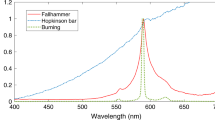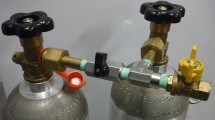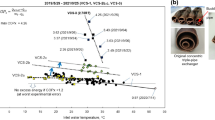Abstract
THOUGH it is generally accepted that chemical changes occur during the operation of an argon chromatographic detector1 the extent of change in normal operation has hitherto been assumed to be small2,3 and to arise almost entirely from ionization, the efficiency of which, even in the triode detector4, rarely exceeds 1 per cent. Having examined (experimental details published in Disc. Faraday Soc., 36, 83; 1963) the breakdown of C2 to C6 paraffins and olefins in an argon ‘detector’ with plane parallel electrodes, we conclude that the extent of chemical reaction can be appreciable, and that excitation of the substrate gas by electron impact is largely responsible. Thus the number of molecules of n-butane decomposed per ion pair produced in such a cell (−M/N) is much greater than unity (Fig. 1), and despite the large errors which arise from the difficulty of measuring small proportions of substrate destroyed, clearly tend to increase with decrease of voltage. The same behaviour is shown by the yields of some, but not all, of the products of decomposition. It is to be expected that the average energy of electrons in the cell will fall with decreasing applied voltage, so favouring excitation of the hydrocarbon rather than that of argon, and we suggest that the results presented in Fig. 1 may be most simply explained on this basis.
This is a preview of subscription content, access via your institution
Access options
Subscribe to this journal
Receive 51 print issues and online access
$199.00 per year
only $3.90 per issue
Buy this article
- Purchase on Springer Link
- Instant access to full article PDF
Prices may be subject to local taxes which are calculated during checkout
Similar content being viewed by others
References
Lovelock, J. E., “A Method of Promoting Chemical Reactions in the Vapour Phase”, Provisional Patent (1958).
Littlewood, A. B., Gas Chromatography (Academic Press, London, 1962).
Lovelock, J. E., J. Chromatog., 1, 35 (1958).
Lovelock, J. E., Third Symp. Gas Chromatography, Edinburgh (June 1960).
Shahin, M. M., and Lipsky, S. R., Anal. Chem., 35, 1562 (1963).
Yamane, M., J. Physic. Soc. (Japan), 15, 1076 (1960).
Author information
Authors and Affiliations
Rights and permissions
About this article
Cite this article
COLLINSON, E., TODD, J. & WILKINSON, F. Occurrence of Chemical Change in the Argon Vapour Phase Chromatographic Detector. Nature 206, 394–395 (1965). https://doi.org/10.1038/206394a0
Published:
Issue Date:
DOI: https://doi.org/10.1038/206394a0
This article is cited by
-
A discussion of the detection mechanism and the response character of the helium detector
Chromatographia (1972)
-
A discussion of the detection mechanism and the response character of the helium detector
Chromatographia (1972)
-
A quantitation problem in the open tubular gas chromatography of fatty acid esters from cod liver lipids
Lipids (1967)
-
Empirical relationships between iodine value and polyunsaturated fatty acid content in marine oils and lipids
Journal of the American Oil Chemists' Society (1966)
Comments
By submitting a comment you agree to abide by our Terms and Community Guidelines. If you find something abusive or that does not comply with our terms or guidelines please flag it as inappropriate.



